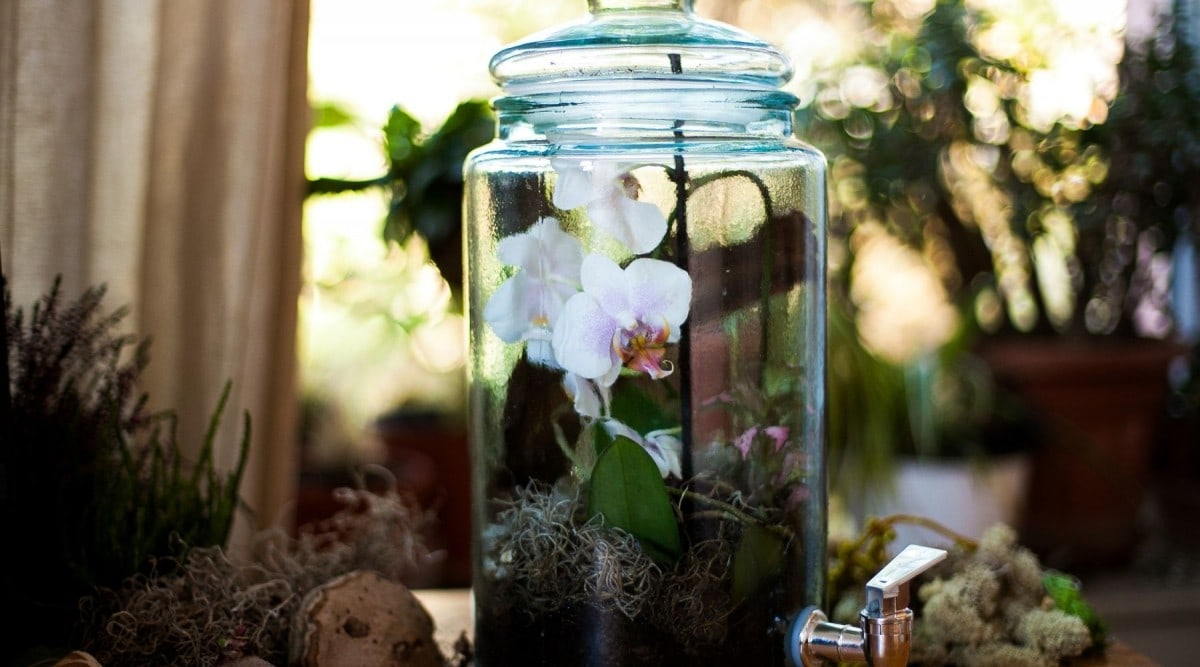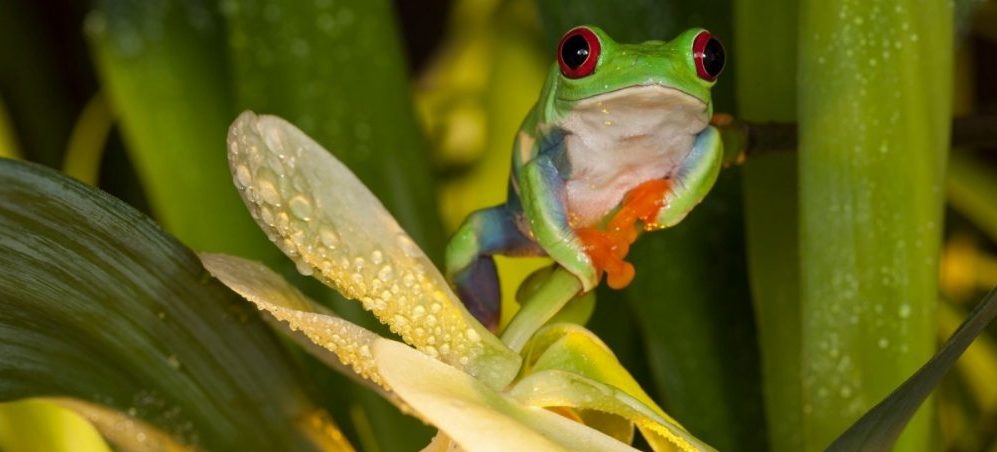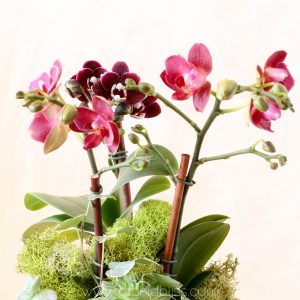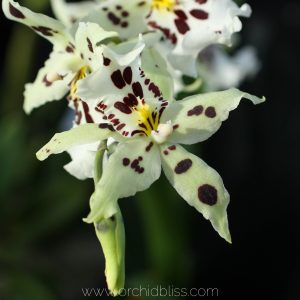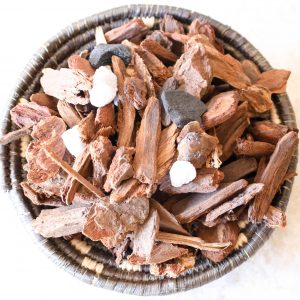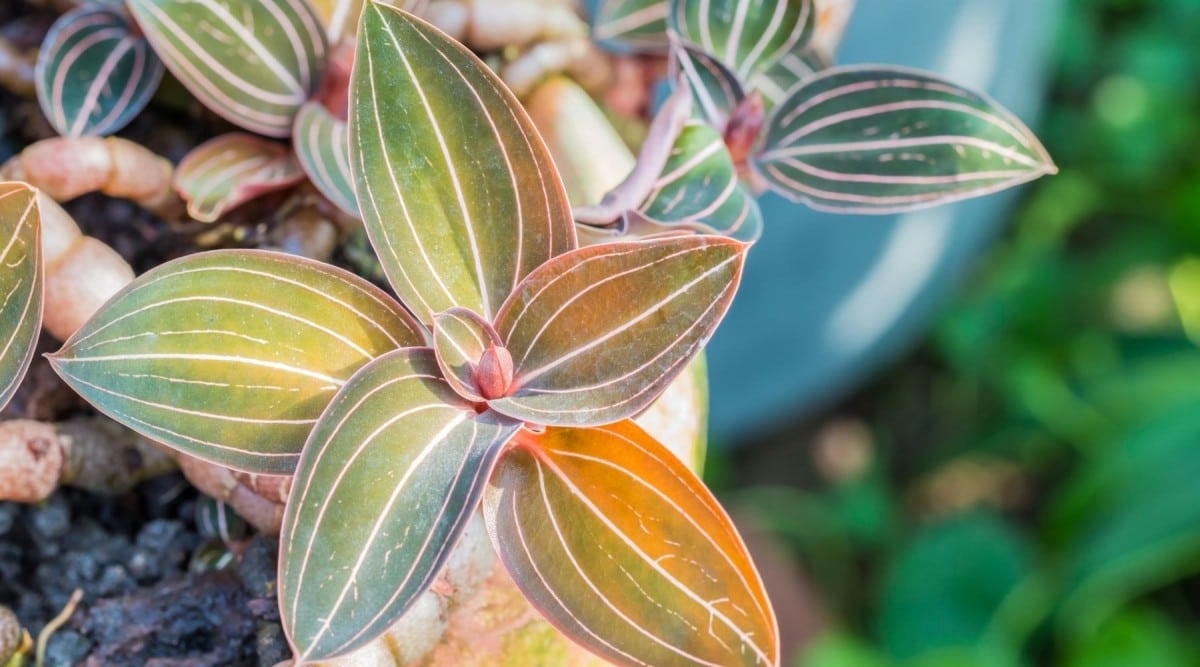
Jewel Orchid Care: The Complete Guide
Jewel orchids are beautiful plants grown for their exquisitely marked foliage. Like most orchids, they require special care to grow and flourish.
To care for a jewel orchid, you’ll need to plant it in a wide, shallow growing pot with orchid mud mix, place it at a sheltered location away from direct sunlight to prevent sun damage, as well as feed and water as needed to avoid root rot. You’ll also need to provide a warm and humid environment.
This article gives you all the information you need to care for your jewel orchid properly, including:
- Overview of jewel orchids
- The growth requirements for jewel orchids
- Common challenges in growing jewel orchids
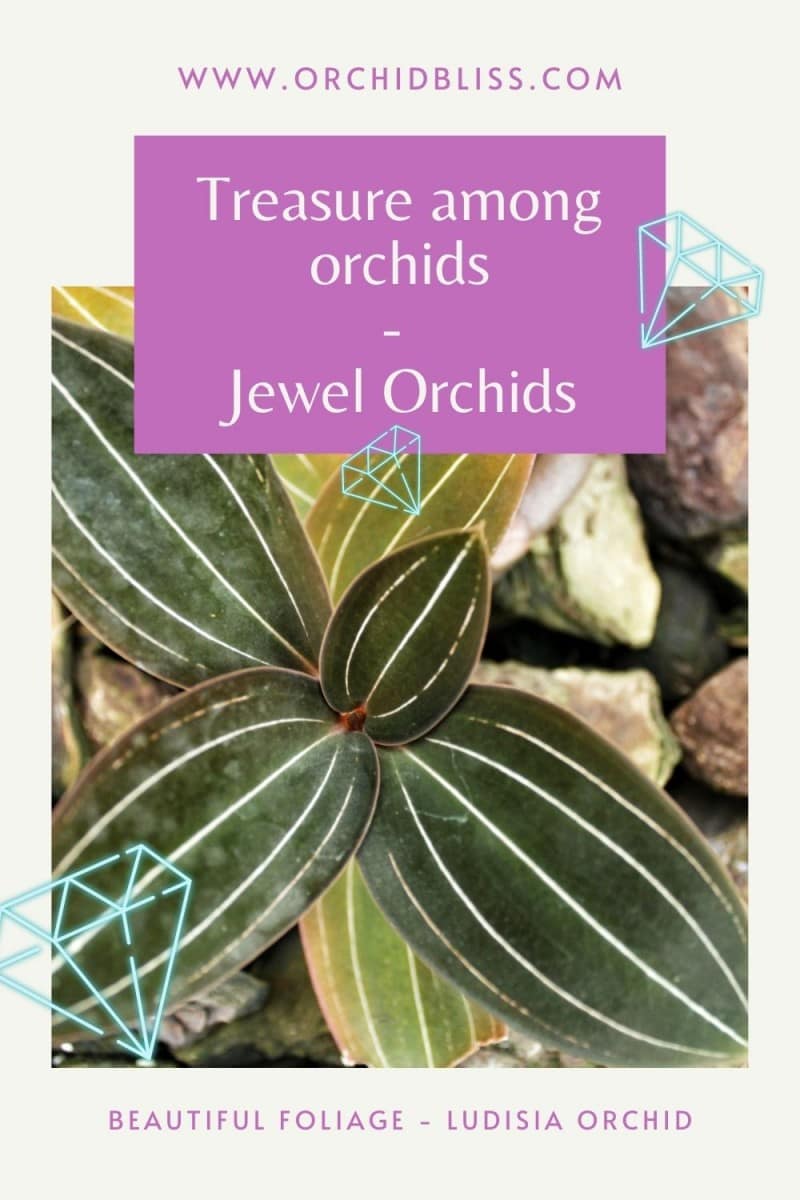
Some of the links on this page may be affiliate links. Click here to learn more.
Overview of Jewel Orchids
Jewel orchids, unlike typical orchids, are grown for their beautiful foliage. They produce less prominent white flowers with off-white centers, but the pretty striped leaves overshadow these.
Given the right care, low light, and high humidity, these special orchids can grow well in terrariums with many varieties of jewel orchids flourishing together in a small space.
Jewel orchids are terrestrial, meaning they grow on the ground, distinguishing them from many other orchids that grow wild as epiphytes. This distinctive feature of jewel orchids implies that though it’s a member of the orchid family, it requires distinctive care.
You’ll want to follow this complete guide to give your orchids the best care.
Get Your Free Jewel Orchid Care Card
For easy care instructions on how to care for jewel orchids, CLICK HERE. You’ll get a PDF downloadable culture sheet with care requirements for jewel orchids.
Origin of Jewel Orchids
Jewel orchid is an umbrella term for orchids with distinctive markings on their leaves. Several species fall into the class of jewel orchids, and they originate mostly from southeast Asia and the Pacific. They are native to Indonesia, the Philippines, Myanmar, and India, but some species have their origins in eastern North America.
The increasing demand for these exotic plants as ornaments has significantly depleted their numbers in the wild. To protect these treasured orchids, be sure to purchase from a reputable seller.
Types of Jewel Orchids
Jewel orchid is a general name to describe the type of orchid with patterned leaves. Some varieties, such as the Ludisia, are native to southeast Asia, while others, like the Downy rattlesnake plantain, call eastern North America home.
Specific types of Jewel orchids call for special care; knowing which type you have will help you provide adequate care.
Here are the most popular types of jewel orchids:
Ludisia
The Ludisia genus has one species under it called Ludisia discolor. This species of orchid have dark green colored leaves with red veins. Ludisia’s variety of orchids is the most famous jewel orchids for a good reason. They tend to be easier, more resilient, and beginner-friendly.
These plants are native to China, Vietnam, Laos, Borneo, Cambodia, Sumatra, Malaysia, Myanmar, Thailand, and the Philippines.
There are several variations of the Ludisia orchid:
- Ludisia discolor ‘Alba’: It is an albino/pale variety.
- Ludisia discolor ‘Nigrescens‘ is referred to as “black velvet” and has darker leaves.
- Ludisia discolor var. ordiana
- Ludisia dawsonia
Dossinia
Dossinia marmorata is the only species under the Dossinia genus. It’s a pretty rare jewel orchid, and it’s native to Borneo. It grows in the soil between rocks, moss, and leaf litter in nature. It has black-green leaves with gold, pink, or greenish-yellow veins.
Anoectochilus
The Anoectochilus is a genus of orchids that have dark-colored leaves and contrasting veins. This genus is also called the marbled jewel orchid, and roughly 50 species of orchids belong here.
The large velvet leaves have a characteristic dark green or brownish-purple color contrasted with silvery or reddish veins.
Anoectochilus loves shade and is naturally occurring in Hawaii, China, Southeast Asia, Melanesia, New Guinea, and Australia.
Though the jewel orchid requires extra effort to grow and maintain, the Anoectochilus seems to be one of the easier types to care for, making them quite popular.
Anoectochilus sandvicensis, the Hawaiian jewel orchid though vulnerable, is a crucial part of Hawaiian flora, and it’s locally referred to as Honohono.
Goodyera
The Goodyera, one of the largest genera of jewel orchids, consists of over 100 species. It’s also called the jade orchid.
Each member has characteristic small white resupinate flowers. The green leaves have white or light green veins, and sticky hairs cover the entire plant.
This genus spreads across Mozambique, Madeira, Australia, Europe, North and Central America, and islands from the western Indian Ocean to the Pacific Ocean.
Macodes
This unique genus of jewel orchids encompasses about 12 species. The most popular species is Macodes Petola.
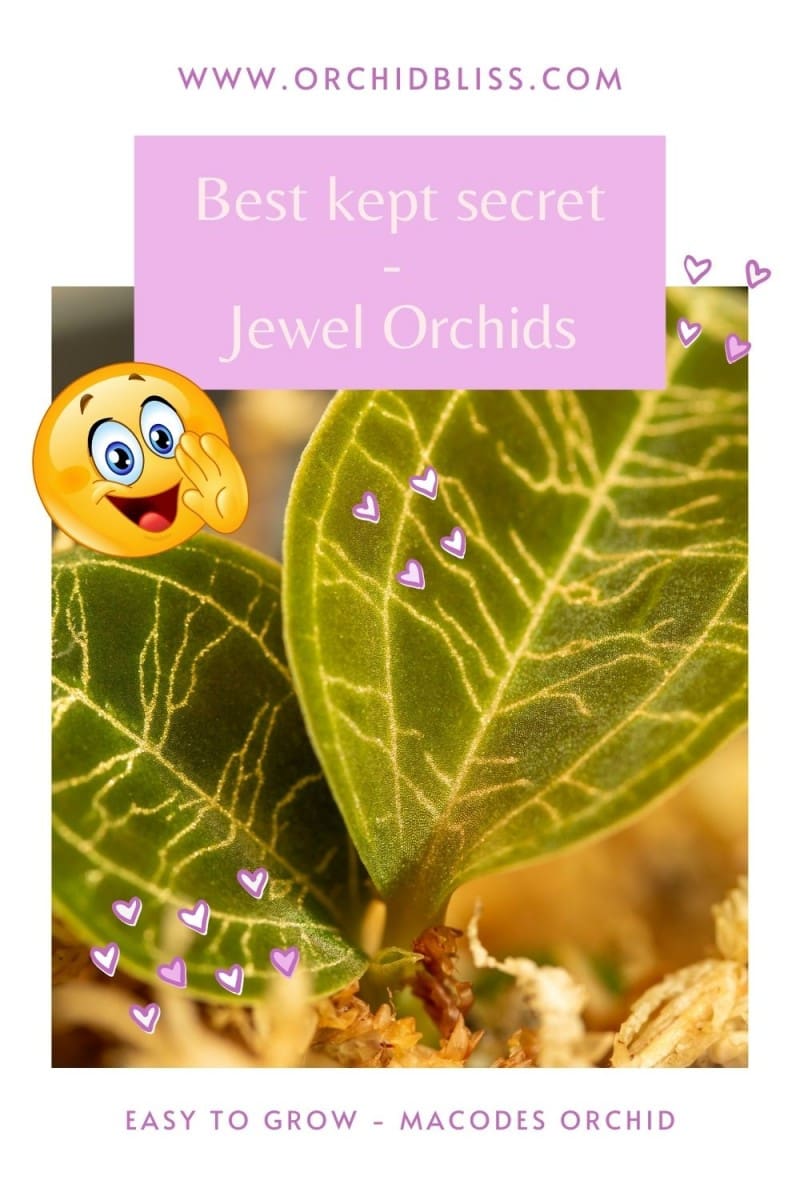
Compared to the others on the list, Macodes require extra attention, and some describe it as the most difficult to grow and maintain.
This plant is native to Southeast Asia, the Ryukyu Islands, New Guinea, the Solomon Islands, and Vanuatu. Gold lightning bolt veins highlight the green leaves of this plant.
Growth Requirements for Jewel Orchids
To grow the jewel orchid, you’ll have to replicate the rainforest conditions where it occurs naturally. That means warm temperatures, humidity, and sunlight. Here are the essential factors for growing jewel orchids:
Soil/Media
The first point to note when growing jewel orchids is the growing media or soil. Unlike many popularly cultivated orchids, jewel orchids are terrestrial, so they need soil to grow.
Common orchids are epiphytes and usually grow from the side of another plant. This difference explains why jewel orchids will not thrive in a regular orchid mix containing mostly orchid bark. Here are some growing media suitable for your jewel orchid:
Orchid Mud Mix
This soil mix consists of 50% peat moss and 50% perlite. The perlite helps to reduce the density of the media and promotes the flow of air.
This media is relatively dense, so you might want to pay close attention when it comes to growing orchids. Water only when the top layer is dry. Persistently overwatering your jewel orchid in this medium would put the roots in a wet environment and at risk of root rot.
Most jewel orchid types thrive in this soil mix provided you get the watering right.
Classic Orchid Mix With Sphagnum Moss
This soil mix consists of 20% bark, 50% sphagnum moss, and 30% perlite. This mix is less dense than the first one, and you’ll need to water frequently to keep your plant healthy.
You might want to pay close attention to the roots. Please don’t let them dry out thoroughly before you water the plant. You may need to water every other day until you create a suitable watering schedule.
Sphagnum Moss
This soil mix consists of only sphagnum moss. When dry, it requires a bit of effort to refresh the sphagnum moss, so it’s essential that you keep it moist at all times but not soaking wet. If you see the moss drying out in between watering, mist lightly with water. You’ll need to be careful with this because it grows more compact as it ages, thus predisposing your jewel orchid to root rot.
Consider repotting your plant every 8-10 months to reduce its chance of root rot if you use sphagnum moss. This soil mix might not work well with Ludisia because it prefers a more airy environment.
Layered Substrate
One of the growing media suitable for your jewel orchid is a layered substrate. Here, you’re creating layers of different substrates for your terrestrial plant. You could place a top layer of sphagnum moss followed by a layer of bark and perlite mix over a sand or gravel base.
Learn more about keeping your orchid’s leaves and roots healthy and grab your free cheat sheet. Click here to grab your cheat sheet to learn how to grow healthier orchids. It will be super helpful.
Light
Plants need light to produce their food, but the quantity of light required varies for each plant. Contrary to popular belief, jewel orchids don’t do well in dark, gloomy areas. They still need a reasonable amount of sunlight to grow properly.
Jewel orchids also don’t do well with direct sunlight, so you might consider placing them away from the windows. A north-facing room or any other location to shield them from direct sunlight is an excellent option.
So, how do you make sure that they’re receiving sufficient sunlight in their new location?
Place your hand over the plant; if there are no shadows, then your plant isn’t receiving enough light. If it casts a strong dark shadow, then the light is too intense for the plant. Finally, a light shadow tells you that you’ve found the perfect spot for your plant.
Jewel orchids respond positively to LED grow lights set at medium intensity for up to 12 hours. These artificial lights will help your plant remain healthy, mostly if you reside at a place where there isn’t enough sunlight or during winter.
You’ll need to look out for signs from your plant about its needs. If you observe it elongating in a specific direction, probably towards the window, it probably isn’t receiving enough sunlight and begging for more illumination.
If you’re planning on growing your jewel orchid outdoors, consider placing it at a sheltered location to save it from getting scorched by the sun.
Water
Jewel orchids need to be appropriately hydrated; remember that their natural habitat—the rainforest—gets enough water. At the same time, they don’t like their roots sitting in a pool of water. Soggy roots can lead to root rot and eventually the death of your plant.
Check the growing medium daily to ensure that the orchid roots aren’t drying out and water accordingly. Dry roots can cause your plant to wilt and die.
As a rule of thumb, water your jewel orchids each time you observe that the topsoil of your growing medium is dry. Consider using distilled water at room temperature instead of tap water, which might contain heavy minerals that can cause nutrient overload. During winter, you might want to reduce how often you water your jewel orchid.
There are two techniques for watering your jewel orchid:
- Water from the top down. Generously pour the water directly at the jewel orchid roots and into the growing medium from the top. You’ll want to lift the leaves to avoid getting water on them. If you do get the leaves wet, pat them dry with a towel.
- Water from the bottom up. Place your potted plant on a tray of water and allow the water to climb up to the jewel’s roots orchid from the bottom up. This is exceptionally useful if you’re using a classic orchid mix with sphagnum moss. This media dries out faster, and using a watering tray will reduce the frequency of top to bottom watering. You’ll still need to flush down the pot from the top down to remove mineral buildup.
Humidity
If you strike a balance in watering, you might not have to bother about maintaining humidity. Consider striking out misting the orchid to maintain humidity because misting improves humidity temporarily and puts your plant at risk of fungal infections. House plants, like jewel orchids, typically enjoy humidity between 50-70%.
Comfortable humidity allows the plants to lose heat and carry out photosynthesis. If conditions remain unfavorable, the leaves can lose chlorophyll and eventually get burnt. House plants tend to require more humidity during the vegetative growing phase, but you might want to cut down during flowering to ward off bud rot.
Your bathroom might not seem like the perfect location to place a house plant, but the humidity in your bathroom would be excellent for your jewel orchid. Consider putting your jewel orchid on your bathroom shelf to add a cozy finish.
Temperature
Generally, your jewel orchids are comfortable at room temperature. They are native to tropical regions, so you might want to look into ways to keep them warm if the temperature falls below 10°C (50°F).
At the same time, we don’t want to cook our plants, so avoid placing them directly in front of a heater or radiator. During winter, position your jewel orchid at least 4 feet (1.2 m) away from the heat source in your home.
The most comfortable temperature for your jewel orchid is between 16°C and 25°C (61°F and 78°F).
Feeding
Jewel orchids are pretty self-sufficient, but you can supplement their nutrition with some plant food to help them attain maximum productivity. You could use a regular orchid food mix once a month or a few times a year, depending on your plants’ needs. Use fertilizers sparingly. Try using liquid fertilizers for accurate measurements.
Consider using a fertilizer ratio of 7-5-6 instead of the typical orchid flower mix because it has a high concentration of phosphorus to encourage blooming. Ensure the fertilizer is sufficiently diluted and apply it in small doses. Try to steer clear of the leaves and give small quantities to prevent a chemical burn.
Repotting
Jewel orchids tend to grow over the surface, not down below, so you’ll want to use a wide shallow pot for your jewel orchid. Providing your jewel orchid with a fresh potting mix gives it more nutrients and promotes airflow. Consider repotting your jewel orchid once a year or when it shows signs of distress.
How do you know your orchid needs to be repotted? Here are a few tips:
- Check for tangled roots. Tangled roots are a sign that your jewel orchid needs some extra space to grow. They’ll appreciate the spare room in a new pot.
- Know when you last repotted. It’s best practice to re-pot your jewel orchids once a year. If you’ve exceeded the one-year mark, check for other signs that your plant needs a new space and do the needful.
- Observe soft brown shoots or falling leaves. If you haven’t repotted in a while, you might notice that your plant’s shoots retain more water and appear soft and brown or lose more leaves than usual. The soggy roots put your plant at risk of fungal infections.
How to Repot Your Jewel Orchid
Now you know when your plant needs to be repotted, here’s how to do it:
- Pick your preferred medium and soak it with water for about 24 hours.
- Gently take out your jewel orchid from its pot and carefully examine its roots. Trim off any dead sections.
- Fill your new container with your selected growing mix.
- Place the main stem in the pot’s center and put other stems close to the pot wall.
- Cover up with some extra soil mix.
- Water your plant generously.
Propagation
You can create additional jewel orchid plants via asexual reproduction. Here are a few techniques:
- Stem cuttings: The stems of jewel orchids are fragile, and you can break them off easily. Cut a fair length, dip in a rooting hormone if you like and place it into the soil. You might see signs of growth in a few months.
- Offshoot separation: You might have to remove the orchid from the pot to carefully separate the offshoot from the parent plant. You can now place the offshoots in a separate pot.
- Air layering: If your jewel orchid has some leggy stems, consider using this method to form new offspring. Give the branch a wound, apply some rooting hormone, wrap in sphagnum, and keep sealed until roots form.
- Rhizome cutting: Cut the creeping rhizomes along the surface. Ensure each section has at least one growth node. Replant the rhizomes lightly into the soil.
Note: Please ensure you use sterile equipment when making cuts to limit the spread of infections. Dip your tools into alcohol in between cuts to sterilize them.
Pruning
Pruning is one of the growth requirements for jewel orchids. You might want to cut down old dead leaves to maintain the beauty and health of your jewel orchid. If your plant is beginning to overgrow past its space, pruning will help keep your plant within your desired shape and size.
Flowers
Jewel orchids aren’t typically grown for their flowers, which are pale compared to the beautifully marked foliage. However, cute flowers can add to the beauty of your plant. Jewel orchids tend to bloom during late fall or winter. If you’d like to take advantage of this period, then you’d have to provide the best possible conditions during the growing phase.
If you’d like to encourage your jewel orchid to bloom, you might want to cause them a bit more stress around fall by reducing watering or moving them to a cooler location.
Several people don’t care for the flowers of the jewel orchid. Flowering can change your plant’s structure and make them more elongated. If you’d like to prevent that from happening, you might consider pinching off the buds before flowering begins.
Jewel Orchid Care Winter
We’ve established that jewel orchids love warm weather, so it shouldn’t come as a surprise that they need special attention during the winter months.
If you’re growing your jewel orchid outdoors, consider bringing it in if temperatures dip below 55.4°F/13°C to get some warmth. Remember to place them some meters away from direct heat.
You might also need to adjust your watering cycle. To be safe, start by watering when you observe the topsoil drying. If you have limited sunlight during this period, your jewel orchid will love some artificial light to keep those leaves looking fresh.
A final note during winter would be to improve humidity. You can combat the dry winter air by moving your jewel orchid to your bathroom.
Jewel Orchid Problems
Several issues come with growing a jewel orchid. This list highlights common issues and proffers solutions.
Overwatering
Overwatering is the most common challenge faced by novice jewel orchid growers. It’s easy to see why beginners drench jewel orchids in water; after all, they’re native to the rainforest.
Unfortunately, drenching your plant in water can negatively impact its health. Root rot is the usual result of overwatering your jewel orchid. Root rot is a dire situation, and it’s challenging to reverse.
Some signs that you’ve overwatered your jewel orchid are:
- Pleated soft yellow leaves
- Bud blast
- Soggy roots
Here’s how to fix it:
- Re-pot your jewel orchid. If you observe there wasn’t significant damage to the roots, consider placing your plant in a fresh soil mix.
- Clip off damaged roots. If you observe dead or damaged roots, use sterilized equipment to cut off the damaged parts. You can follow up by repotting the plant.
- Review your watering schedule. You’ll have to adjust your watering schedule to protect your plant from future water damage. You might want to consider changing the temperature and humidity too. Water damage and root rot could also be the result of low temperature.
Bleached Crispy Leaves
Jewel orchids need shielding from direct sunlight to help them attain their full potential. Persistent direct sunlight on the plants can cause them to lose some of their chlorophyll and take on a bleached look. It could eventually lead to burnt leaf tips.
Luckily you can fix this quickly by moving your plant to a shaded area. Remember to use the shadow test to determine if the plant receives sufficient sunlight in the shaded area.
Pests
When it comes to these unwanted visitors, prevention is the best option. You’ll want to spend some time inspecting your plant for pests. Detecting them early means you can deal with them on time and nurse your plant back to health quickly.
Some common pests of the jewel orchid include:
- Aphids
- Scales
- Mites
- Ants
Pests that suck the sap of your jewel orchids can cause them to become dehydrated with curled leaves.
If you identify a pest problem, remember that the plant is fragile, so consider using gentle pest control means.
The easiest way to control pests would be to dab any pest you identify with an alcohol-soaked towel. Another common way to deal with pests is to hose them down. The pressured water flushes off pests clinging to your plant. You could also try manually removing pests you see or applying horticultural oils.
You might want to isolate the pest-infested plant to prevent the pests from migrating to other plants.
Not Flowering
If you appreciate the jewel orchid’s flowers in addition to the pretty foliage, then we understand being upset if your plant fails to flower during winter.
You might want to consider how much care your plant received during the growing months. Jewel orchids need to have received adequate sunlight, feed, and water during the growing phase to produce flowers during winter.
If you’re sure your plant has received the right amount of care during the growing phase, then maybe all your plant needs are some stress to promote flowering. Consider moving the plant further away from sunlight to a cooler location or reducing watering frequency and observing how the plant reacts.
White Mold
All house plants are at risk of developing white mold due to limited ventilation. You might observe this cotton-like fluff in the soil or around the root of your plant.
White mold is easy to fix, and you need only to rake out the affected soil. You’ll want to improve airflow to your plant after this. Consider moving it closer to a window but away from direct sunlight.
Dry Roots
Please strike a balance in watering. Your plant needs water but not too much. In trying to prevent overwatering, some people end up under-watering.
Insufficient water could result in your jewel orchids having dry roots. Dry roots become stunted and would halt the growth of your plant.
As a rule, water each time you observe the topsoil is drying out, and use that to set up a watering schedule for your plant.
Conclusion
Jewel orchids are delightful additions to your living space. Now that you know all about caring for a jewel orchid, you can confidently purchase one for your home.
Here’s a rundown of the tips in this article:
- Shield your orchid from direct sunlight but ensure they receive sufficient light.
- Water only as needed; observe that the topsoil is dry before watering again.
- Provide plant feed and fertilizer a few times a year.
- Provide a comfortably warm and humid growing environment.
- Deal with problems like root rot, pests, and sun damage swiftly.

